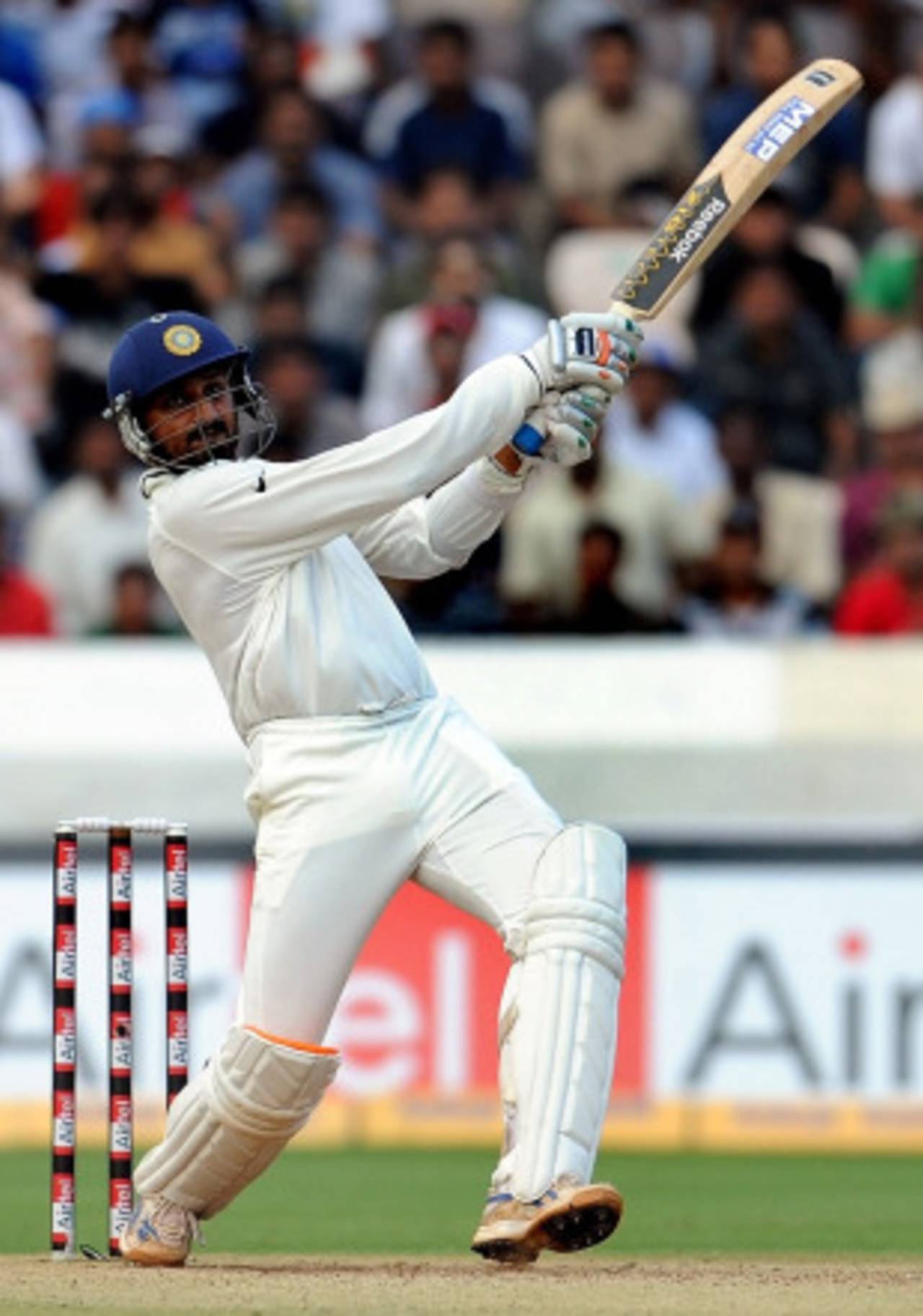Flat pitch can't hide India's bowling woes
The Hyderabad pitch may have been great for batting, but that shouldn't overshadow India's bowling problems
ESPNcricinfo staff
16-Nov-2010

Harbhajan Singh may be making merry with the bat, but he has struggled with the ball • AFP
Player after player came to the press conferences and spoke of how this was a better pitch because it had "more bounce". At the end of five days though, the result is exactly the same as it was in Ahmedabad, where Chris Martin's superb new-ball spell in the second innings provided the only drama on a surface every bit as poor as the national highway prepared for Sri Lanka in 2009.
India picked up four wickets in two sessions on Monday. Tim Southee was bowled by Sreesanth, who celebrated as though he had just broken the game open. The other three were gifts. Kane Williamson got a terrible decision, Daniel Vettori slapped one to cover with the game safe, and Brendon McCullum skied one after having toyed with the bowling for more than nine hours.
What will the "pitch experts" say now? Before they came along to ruin the majority of Indian pitches, the country did produce some engrossing Test matches. You only have to look back at the memorable series against Australia in 2001. Mumbai, Kolkata and Chennai all produced results, with the final two games going the distance. Each surface was different from the other, yet they all provided great stages for the tussle between bat and ball.
MS Dhoni was scathing in his assessment of the conditions when asked about the 0-0 scoreline heading to Nagpur. "We might have to play 10 days to get a result," he said. "That's what I frankly believe. The wickets have been on the flatter side. We didn't play well for one hour in the last Test, but that aside, there's been little over the 10 days for seam bowlers or spinners."
On a day when bowlers from the three highest-ranked teams in the world took a pounding, it might be worthwhile to ponder the wisdom of a Test championship. How exactly will it resuscitate interest in the venerable form of the game when boards and groundsmen worldwide are failing the most basic test? Even New Zealand, once known for its seam-friendly surfaces, has recently come up with pitches that would have done justice to timeless Tests.
The pitches in England this past summer sometimes went to the other extreme, but you'd rather have that and the excitement of seeing batsmen tested than games like this, where a total of 500 becomes the mundane norm rather than the exception. Yes, there was bounce on offer in Hyderabad, but at the end of five days, the surface was as free of blemishes as the airbrushed faces in fashion magazines.
India are entitled to a little whinge about the lack of deterioration even on the final day, but with the Nagpur Test just days away, energy would be better expended on an analysis of a bowling attack that was once again made to look utterly insipid. Zaheer Khan, who struggled with a groin strain in this game and will miss the next, is exempt from criticism, having taken 41 wickets at 22.92 this year. His strike-rate of 41.2 is outstanding for someone who has played each of those eight Tests on the subcontinent.
Dhoni refused to accept suggestions that the team was too reliant on Zaheer, but his response only highlighted how central he is to India's bowling plan. "We have others who have done well," he said. "You can say that he's been our spearhead, whatever the track may be. But we lost him in the middle of this game and it became a bit tough. The other bowlers are doing their job though. With a bit more assistance from the pitch, I hope they'll be able to get batsmen out."
As for the support cast, the less said the better. Harbhajan Singh has 31 wickets at 44.7 from nine Tests. He's needed more than 97 balls for each of those wickets. As for Pragyan Ojha, he has 28 wickets at 46.96 from eight games. His strike-rate? 100.3. The fact that they've often had to do containing jobs in the early stages of games on lifeless pitches is a mitigating factor, but what shouldn't be overlooked is how Daniel Vettori has bowled immeasurably better than both so far in the series.
Against a better line-up than Harbhajan and Ojha have had to contend with, Vettori has varied his flight and pace beautifully to compensate for the lack of turn and uneven bounce. India's fifth-day bowling, by contrast, was a monotonous succession of balls pushed through at the batsmen, with the field spread out and runs there for the taking.
When Zaheer hasn't been taking wickets, with new ball and old, India have largely been devoid of plan B. The default option appears to be containment, and against a team like New Zealand that have played the waiting game with aplomb, it's come a cropper. Instead of forcing the issue with aggressive bowling and fields to back it up, India have gone on the defensive against an opponent too smart to fall for the rope-a-dope.
In life, good things might come to those that wait. But in cricket, as in most sport, victory is the preserve of those that make things happen.